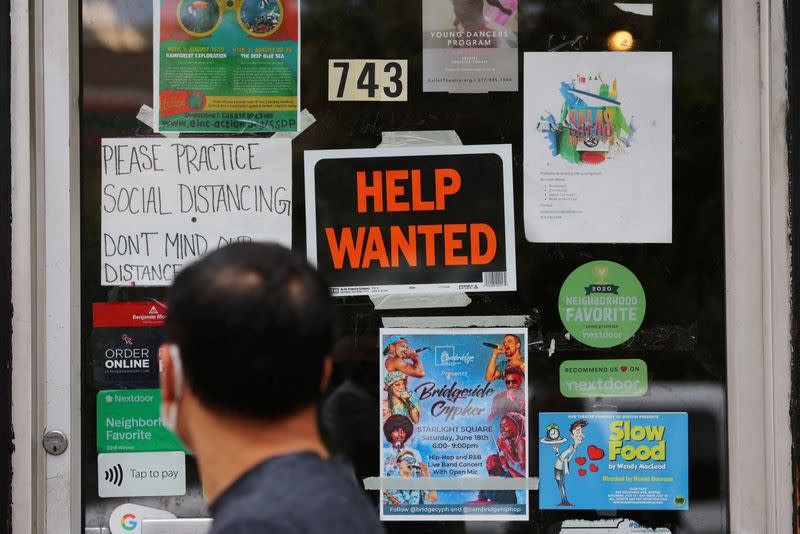US labor market, housing data point to slowing economy

By Lucia Mutikani and Lindsay Dunsmuir
WASHINGTON (Reuters) - First-time applications for U.S. unemployment benefits fell moderately last week, while new housing construction dropped to the lowest level in nearly four years in May, suggesting that economic activity remained moderate in the second quarter.
The data on Thursday combined with tepid retail sales last month to keep a September interest rate cut from the Federal Reserve on the table. Financial markets are anticipating one or more rate cuts this year despite policymakers' more hawkish outlook. Momentum is ebbing under the weight of the higher borrowing costs engineered by the U.S. central bank.
"Economic indicators for the second quarter largely point to another slow quarter of economic activity," said Bill Adams, chief economist at Comerica. "Soft activity and labor market data reinforce expectations for the Fed to begin cutting interest rates in a few months ... an initial cut in September, and a second cut in December."
Initial claims for state unemployment benefits declined 5,000 to a seasonally adjusted 238,000 for the week ended June 15, the Labor Department said. That reversed only about a third of the surge in the prior week, which had pushed up claims to a 10-month high. Economists polled by Reuters had forecast 235,000 claims in the latest week.
Claims had soared in the prior week, with a dozen states reporting significant increases. Some states reported a rise in layoffs in the education, transportation and warehousing, accommodation and food services, manufacturing as well as agriculture, healthcare and retail industries.
The four-week average of claims, which smoothes out some of the volatility in the data, increased 5,500 to 232,750 last week. That was the highest reading since mid-September.
"Claims are trending up," said Ian Shepherdson, chief economist at Pantheon Macroeconomics. "The Fed is too sanguine on unemployment."
The Fed has maintained its benchmark overnight interest rate in the 5.25%-5.50% range since last July, and at its meeting last week officials revised down the number of rate cuts they anticipate delivering this year to just one quarter-point reduction from a projection of three as recently as March.
The claims data covered the period during which the government surveyed employers for the nonfarm payrolls component of June's employment report. Claims rose between the May and June survey weeks.
Though job growth accelerated in May, that likely overstates the health of the labor market. The unemployment rate rose to 4.0% in May for the first time since January 2022 amid signs that laid off workers could be having a harder time finding new jobs.
Data next week on the number of people receiving benefits after an initial week of aid, a proxy for hiring, could offer more clues on the state of the labor market in June.
The so-called continuing claims edged up to a seasonally adjusted 1.828 million during the week ending June 8, the highest since January.
"Initial claims suggest that the gain in nonfarm employment in May won't be duplicated in June," said Ryan Sweet, chief U.S. economist at Oxford Economics. "The risks to the labor market should be garnering attention by the Federal Reserve."
Stocks on Wall Street were trading higher. The dollar rose against a basket of currencies. U.S. Treasury prices fell.
WEAK HOMEBUILDING
A separate report from the Commerce Department's Census Bureau showed housing starts fell 5.5% to a seasonally adjusted annual rate of 1.277 million units last month, the lowest since June 2020. Economists had forecast starts rebounding to a rate of 1.370 million units.
Starts tumbled 19.3% year-on-year in May. New construction had been boosted by an acute shortage of houses, especially entry-level homes. But that momentum was snuffed out by a surge in mortgage rates this year. The average rate on the popular 30-year fixed mortgage raced to a six-month high of 7.22% in early May before retreating to just below 7.0% by the end of the month, data from mortgage finance agency Freddie Mac showed.
Though the 30-year fixed mortgage rate has since pushed further below 7.0%, it could take a while for housing starts to rebound. Confidence among homebuilders hit a six-month low in June, with the National Association of Home Builders on Wednesday complaining that "persistently high mortgage rates are keeping many prospective buyers on the sidelines."
Economists at Goldman Sachs pared their GDP growth estimate for the second quarter to a 1.9% annualized rate from a 2.0% pace. The economy grew at a 1.3% pace in the first quarter.
Single-family housing starts, which account for the bulk of homebuilding, declined 5.2% to a rate of 982,000 units last month, the lowest since October.
Permits for future housing construction, an indication of projects in the pipeline, tumbled 3.8% - like starts, the lowest since June 2020. Single-family permit filings fell 2.9% to a rate of 949,000 units, the lowest in nearly a year.
"The drop in housing starts in May is consistent with the recent slowdown in permit issuance, pointing to construction continuing to falter this year," said Thomas Ryan, North America economist at Capital Economics.
(Reporting by Lucia Mutikani, Lindsay Dunsmuir and Dan Burns; Editing by Chizu Nomiyama and Andrea Ricci)

